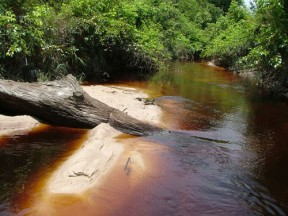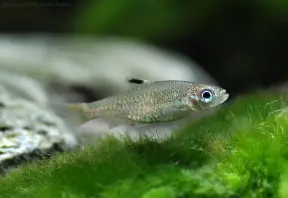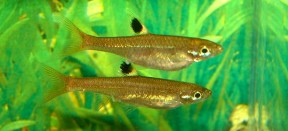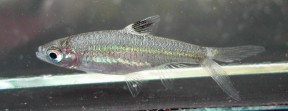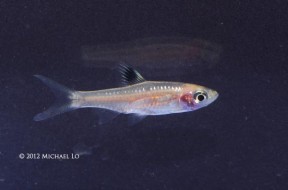Brevibora dorsiocellata
Eyespot Rasbora
SynonymsTop ↑
Rasbora dorsiocellata Duncker, 1904
Etymology
Brevibora: from the Latin brevis, meaning ‘shorts, and ‘bora’ from Rasbora, a genus from which Brevibora was split, in allusion to the few predorsal vertebrae compared to related species.
dorsiocellata: from the Latin dorsum, meaning ‘back, summit, and ocellatus, meaning ‘ocellated, having small eyes’, in reference to the dark, rounded marking in the dorsal-fin of this species.
Classification
Order: Cypriniformes Family: Cyprinidae
Distribution
Native to southern Thailand, Peninsular Malaysia and the Greater Sunda islands of Borneo and Sumatra. Type locality is ‘Muar River, Tebinh Tinggi, Johore, Malaysia’.
In Peninsular Malaysia localities include the Selai and Muar rivers in Johor state and the blackwater swamp lake of Tasek Bera in Pahang state while in Sumatra the only report we’ve been able to find seems to refer to the Lalah River, Riau province in the east of the island.
Records from Borneo are confusing.
It was once thought restricted to southern (Indonesian) parts of the island and has been recorded from various rivers and streams within the lower Kapuas River basin and the Ketungau river in West Kalimantan (Kalimantan Barat) province as well as tributaries of the Sebangau and lower Mentaya rivers in Central Kalimantan (Kalimantan Tengah).
However it appears possible that some or even all of the records from the Kapuas may actually refer to Brevibora cheeya.
Until a scientific comparison between the forms of the species from the islands and mainland is conducted it is unlikely that the truth will be known.
In any case wild caught fish are quite rare in the hobby as the species is being produced commercially in several countries.
Habitat
Mostly inhabits gently flowing black water streams and rivers associated with ancient forest peat swamps.
The water is stained brown due to the release of tannins and other chemicals released by decomposing organic matter and the substrate scattered with fallen leaves, twigs and branches.
Such environments characteristically contain very soft (negligible hardness), acidic (pH as low as 4.0) water and are often dimly-lit due to the forest canopy above.
Unfortunately these biotopes are under threat from rubber or palm oil plantations, building developments and other human activities across much of Southeast Asia.
Maximum Standard Length
30 – 35 mm.
Aquarium SizeTop ↑
A group will need an aquarium with base dimensions of 45 ∗ 30 cm or more.
Maintenance
Choice of décor is not as critical as water quality although this species does look particularly effective in a well-planted tank with a dark substrate.
To see it at its best a natural-style set-up can also make an interesting project.
In this case a soft, sandy substrate is probably the best choice to which can be added a few driftwood roots and branches placed in such a way that plenty of shady spots are formed.
If you can’t find driftwood of the desired shape common beech or oak is safe to use if thoroughly dried and stripped of bark.
The addition of dried leaf litter further emphasises the natural feel and as well as offering even more cover for the fish brings with it the growth of microbe colonies as decomposition occurs.
Such microorganisms can provide a valuable secondary food source for fry whilst the tannins and other chemicals released by the decaying leaves are thought to be beneficial for blackwater fish species.
Leaves can be left in the tank to break down fully or removed and replaced every few weeks.
This species will do best under fairly dim lighting although this does not preclude the use of aquatic plants with Microsorum, Taxiphyllum or Cryptocoryne spp. all able to survive in such conditions.
Water Conditions
Temperature: 20 – 25 °C
pH: The widely available, captive-bred fish are quite adaptable and should be happy within the range 5.0 – 7.5. If you have the opportunity to purchase wild specimens they are likely to do best on the acidic side of neutral.
Hardness: 18 – 179 ppm
Diet
Stomach analyses of wild specimens have revealed it to be a micropredator feeding on small insects, worms, crustaceans and other zooplankton.
In the aquarium it will accept dried foods of a suitable size but should ideally should be offered daily meals of small live and frozen fare such as Daphnia, Artemia and suchlike.
Behaviour and CompatibilityTop ↑
This species is very peaceful indeed making it an ideal resident of the well-chosen community tank.
As it places no special demands in terms of water chemistry it can be combined with many of the most popular fish in the hobby including other small cyprinids as well as tetras, livebearers, dwarf cichlids, catfish and loaches.
As always when selecting a compatible community of fish thorough research is essential and its small adult size must be a consideration.
Some of the more commonly exported species with which it lives in nature include Striuntius lineatus, Desmopuntius pentazona, Trigonopoma pauciperforatum, Rasbora einthovenii, and various Pangio spp.
It also makes an ideal companion for anabantoids such as Sphaerichthys or the more diminutive Betta species.
It’s a schooling fish by nature and should be kept in a group of at least 8-10 specimens.
Maintaining decent numbers will not only make the fish less nervous but result in a more effective, natural-looking display, while males will also display their best colours as they compete with one other for female attention.
Sexual Dimorphism
Mature females are noticeably rounder-bellied and often a little larger than males.
Reproduction
Like many small cyprinids this species is an egg-scattering, continuous spawner that exhibits no parental care.
That is to say when the fish are in good condition they will spawn often and in a densely-planted, mature aquarium it is possible that small numbers of fry may start to appear without intervention.
However if you want to increase the yield of fry a slightly more controlled approach is required.
The adult group can still be conditioned together but one or more smaller containers should also be set up.
These should be very dimly lit with the base either left bare or covered with some kind of mesh of a large enough grade so that any eggs that fail to adhere to the plant can pass through but small enough so that the adults cannot reach them. The widely available plastic ‘grass’-type matting can also be used and works very well for related species.
The water itself should be of slightly acidic to neutral pH with a temperature towards the upper end of the range suggested above.
An internal power filter can be added initially and this should be positioned so that the flow is directed down the full length of the tank.
When the adult fish are well-conditioned and the females appear full of eggs one or two pairs should then be introduced to each container.
Spawning can be initiated by adding small amounts of cool water every few hours in such a way that the tank is gradually topped up and feeding live and frozen foods several times throughout the day.
Several spawning events normally occur before a female is spent of eggs.
The adults will likely eat any eggs they find and are best removed after a couple of days at which point the power filter should be switched for a mature sponge-type unit in order to avoid fry being sucked into the mechanism.
Incubation in related Rasbora spp. is temperature-dependant to an extent but usually takes between 18 and 48 hours with the young free-swimming 24 to 48 hours later.
Initial food should be Paramecium or similar introducing Artemia nauplii, microworm and suchlike once the fry are large enough to accept them.
NotesTop ↑
B. dorsiocellata is sometimes traded as ‘green-eyed’, ’emerald-eyed’ or ‘hi-spot‘ rasbora.
There appear to exist several geographical forms of the species at least two of which have been seen in the trade.
The most common is the rather plain-coloured fish that is produced commercially in large numbers and has gained popularity due to the bright greenish-blue reflective patch in the lower part of the eye.
The other is only available from time-to-time and in all likelihood is wild caught.
It’s particularly attractive because the caudal peduncle and base of the caudal fin are suffused with a russet red colouration, the extent and intensity of which can vary depending on the mood, condition and sexual maturity of the fish.
B. cheeya Liao and Tan, 2011 can be told apart from B. dorsiocellata by a combination of characters as follows: lateral line complete (25-30 pored scales vs. 4-9); more scales in the lateral row (29-32 vs. 25-27); larger adult size (39.0 mm SL vs. 23.0 mm SL); larger head and prepectoral length (head length 28.5-30.0% SL, vs. 24.4-27.9; prepectoral length 29.6-32.9% SL, vs. 25.8-28.8). B. exilis Liao & Tan, 2014 is distinguished from the other species by the following characters: 10 circumpeduncular scales (vs. 12); anterior outline of dorsal-fin blotch ranging from 2nd unbranched ray to first four or five branched rays with transparent inter-radial membrane between 1st and 2nd unbranched rays (vs. blotch extending from 1st unbranched ray and inter-radial membrane between 1st and 2nd unbranched rays not hyaline), and relatively more slender body (body depth 19.3-24.7 % SL, vs. 24.4-26.7).
Several years prior to its description Grant (2002) suggested that specimens of B. cheeya in the aquarium trade might represent the subspecies Rasbora dorsiocellata macrophthalma (Meinken, 1951) which was described using a specimen from the aquarium trade from the vague locality ‘Malay Peninsula’.
Liao and Tan (2011) argue out that the type specimen of R. d. macrophthalma has been lost and that even if proved a genuine species the validity of B. cheeya would be unaffected since it possesses a complete lateral line (vs. incomplete in R. d. macrophthalma).
The genus can be distinguished by the following combination of characters: palatine process rectangular with a narrow base and lacking projection; a median black blotch in the dorsal fin; low number of predorsal vertebrae (8-9, 6:3 vs. more than 9 in other rasborin genera).
Rainboth’s ‘Fishes of the Cambodian Mekong’ characterised members of Rasbora by possession of an unbranched, non-spiny first dorsal-fin ray and seven soft dorsal rays, origin of the dorsal fin in the middle of the body, five branched anal-fin rays, a small mouth not extending below the eye and a lack of barbels.
It has long been recognised as a polyphyletic lineage and Liao et al. (2010) proposed a number of taxonomical changes based on the results of their phylogenetic analysis.
The authors found species of rasborin genera to represent a monophyletic grouping existing in six clades, and erected four new genera (all containing former members of Rasbora) in order to preserve monophyly of the existing groups, i.e., Boraras, Horadandia, Rasbora, Rasboroides and Trigonostigma.
The first clade is monotypic, comprising only Kottelatia brittani (formerly Rasbora brittani) while the second contains only the genus Brevibora.
The third clade comprises Boraras, Horadandia, Rasboroides, Trigonostigma and three species previously included in Rasbora but moved into new genera; Trigonopoma gracile, T. pauciperforatum and Rasbosoma spilocerca.
The results for Boraras and Trigonostigma were found to be inconclusive in some respects and further work regarding their phylogenetic position was recommended.
The fourth clade includes Rasbora semilineata, R. borapetensis, R. rubrodorsalis and an undescribed fish similar to R. beauforti.
Clade five consists of the R. daniconius species assemblage, R. hubbsi, R. paucisqualis, R. wilpita, R. kobonensis, and R. ornata.
Clade six, meanwhile, is subdivided into two groupings of which the first contains R. einthovenii, R. elegans and R. cephalotaenia and the second R. lateristriata, R. argyrotaenia, R. volzii, R. paviana, R. rasbora (plus an undescribed, similar fish), R. caudimaculata and R. trilineata.
Since this latter clade contains the type species (see below) its members retain the generic name Rasbora as do clade five species because they don’t differ sufficiently to warrant the erection of a separate genus.
Unfortunately many species weren’t included in the analysis, meaning inevitable questions are raised regarding the correct placement of the 40 or so other Rasbora spp., in particular.
As the genus had previously been split into various ‘species groups’ (putative assemblages of closely-related species) dating back to Brittan (1972, who referred to them as ‘species complexes’) Liao et al. proposed the following arrangement whilst noting it may be subject to change with further phylogenetic studies:
R. semilineata species group: R. semilineata, R. borapetensis, R. rubrodorsalis.
R. trifasciata species group: R. trifasciata, R. amplistriga, R. bankanensis, R. dies, R. ennealepis, R. hubbsi, R. johannae, R. meinkeni, R. paucisqualis, R. rutteni, R. sarawakensis, R. taytayensis, R. tobana, R. tuberculata.
R. daniconius species group: R. daniconius, R. caverii, R. kobonensis, R. labiosa, R. ornata, R. wilpita.
R. einthovenii species group: R. einthovenii, R. cephalotaenia, R. elegans, R. jacobsoni, R. kalochroma, R. kottelati, R. nematotaenia, R. tubbi.
R. argyrotaenia species group: R. argyrotaenia, R. aprotaenia, R. aurotaenia, R. baliensis, R. borneensis, R. bunguranensis, R. dusonensis, R. evereti, R. hobelmani, R. hossi, R. lateristriata, R. laticlavia, R. leptosoma, R. philippina, R. septentrionalis, R. spilotaenia, R. steineri, R. tawarensis, R. tornieri, R. volzii.
R. sumatrana species group: R. sumatrana, R. atridorsalis, R. calliura, R. caudimaculata, R. dorsinotata, R. notura, R. paviana, R. rasbora, R. subtilis, R. trilineata, R. vulgaris.
Not classified: R. beauforti, R. chrysotaenia, R. gerlachi (validity in question), R. kalbarensis, R. reticulata, R. vulcanus (possibly not Rasboras) and R. zanzibarensis (identity in question).
Shortly afterwards a paper investigating systematics of the subfamily Danioninae, with significantly different conclusions, was published by Tang et al. 2010.
The four new genera proposed by Liao et al., plus Boraras and Trigonostigma, were synonymised with Rasbora based on an incomplete knowledge of relationships within the group, an approach described as ‘more conservative’, but this approach was dismissed by Kottelat (2013), who is followed here.
References
- Duncker, G., 1904 - Mitteilungen aus dem Naturhistorischen (Zoologischen) Museum in Hamburg v. 21: 133-207
Die Fische der malayischen Halbinsel. - Grant, S., 2002 - BSSW Report Heft 4(2002): 13-17
Zur Identität und Gültigkeit von Rasbora macrophthalma MEINKEN, 1951 (Cyprinidae, Rasborinae). - Kottelat, M., 1999 - Raffles Bulletin of Zoology 47(2): 591-600
Nomenclature of the genera Barbodes, Cyclocheilichthys, Rasbora and Chonerhinos (Teleostei: Cyprinidae and Tetraodontidae), with comments on the definition of the first reviser. - Kottelat, M., 2013 - The Raffles Bulletin of Zoology Supplement 27: 1-663
The fishes of the inland waters of southeast Asia: a catalogue and core bibiography of the fishes known to occur in freshwaters, mangroves and estuaries. - Liao, T-Y., and H. H. Tan, 2011 - Raffles Bulletin of Zoology 59(1): 77-82
Brevibora cheeya, a new species of cyprinid fish from Malay Peninsula and Sumatra. - Liao, T. Y. and H. H. Tan, 2014 - Ichthyological Exploration of Freshwaters 24(3): 209-215
Brevibora exilis, a new rasborin fish from Borneo (Teleostei: Cyprinidae). - Liao, T. Y., Kullander, S. O. and F. Fang, 2010 - Zoologica Scripta 39(2): 155-176
Phylogenetic analysis of the genus Rasbora (Teleostei: Cyprinidae). - Mayden, R. L., K. L. Tang, K. W. Conway, J. Freyhof, S. Chamberlain, M. Haskins, L. Schneider, M. Sudkamp, R. M. Wood, M. Agnew, A. Bufalino, Z. Sulaiman, M. Miya, K. Saitoh, and S. He, 2007 - Journal of Experimental Zoology, Molecular Development and Evolution 308B: 1–13
Phylogenetic relationships of Danio within the order Cypriniformes: a framework for comparative and evolutionary studies of a model species. - Tang, K. L., M. K. Agnew, W. J. Chen., M. V. Hirt, T. Sado, L. M. Schneider, J. Freyhof, Z. Sulaiman, E. Swartz, C. Vidthayanon, M. Miya, K. Saitoh, A. M. Simons, R. M. Wood and R. L. Mayden, 2010 - Molecular Phylogenetics and Evolution 57(1): 189-214
Systematics of the subfamily Danioninae (Teleostei: Cypriniformes: Cyprinidae).

